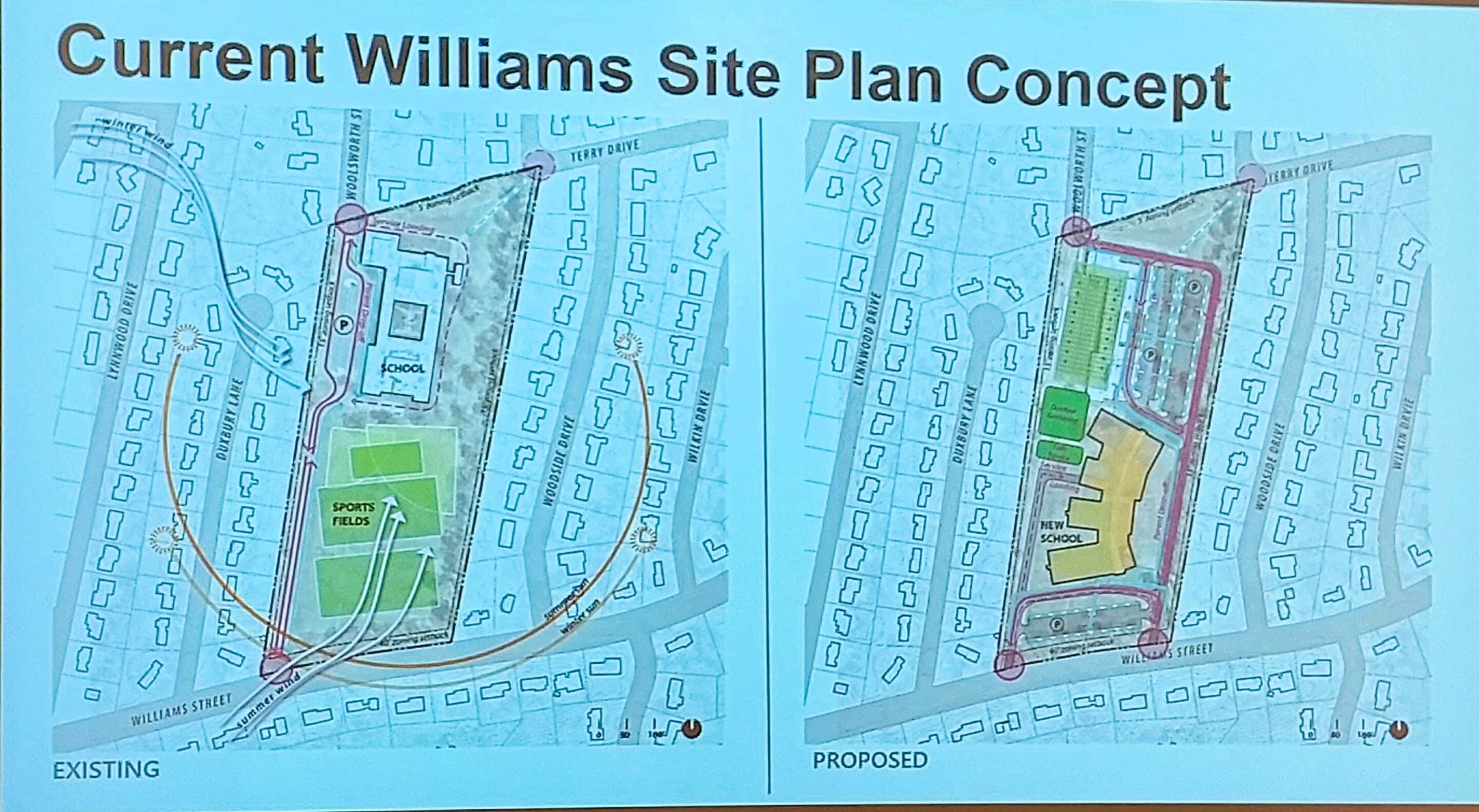A preliminary site design by Jones Whitsett Architects shows the exisitng Williams Middle School site and where a newly constructed school might be located.
Reminder Publishing photo by Sarah Heinonen
LONGMEADOW — About 50 people turned out for a public update and listening session regarding Longmeadow’s middle school project. The June 18 meeting at the Adult Community Center featured a presentation with early ideas for a combined middle school on the existing Williams Middle School campus.
Despite no firm plans having been made, for many in the audience, the location was reason enough to be upset.
“We are in the middle of a long road,” Longmeadow Public Schools Superintendent M. Martin O’Shea told the crowd. Explaining the need for a new middle school, he said Glenbrook and Williams middle schools are “at the end of their educational life,” having been built in 1967 and 1959, respectively. Both schools are undersized for modern middle schools. O’Shea explained that with fewer than 350 students at each school, the facilities must share teachers, a librarian and special education services.
The town is engaged in a feasibility study with the Massachusetts School Building Authority, a semi-governmental agency that reimburses municipalities for public school construction and updates. However, the MSBA is quite particular about what projects it accepts, which is why Middle School Building Committee Chair Armand Wray said it took nine years to get to this point in the process.
The committee has considered several options, including bringing the existing buildings up to code, renovating and adding on to one of the schools, or building a new combined school.
A code upgrade would cost roughly $80 million per school. Resident William DeGiulio asked why the price tag was so high. Dorrie Brooks of architectural firm Jones Whitsett explained that building codes are substantially different now than when the schools were built. The buildings would need new electrical, plumbing and heating, ventilation and air conditioning systems. They would also need to be reclad to meet modern insulation requirements.
A combined middle school, whether new construction or added onto one of the existing schools is the preferred option at this point. It would allow more opportunity to offer an array of academic classes and extracurricular activities, O’Shea said. He added that students who move on to the same middle school as their peers would share experiences. Combining the schools would also save on overhead. Wray noted that it also opens the other middle school campus to redevelopment.
The cost of a renovation and addition to one of the two existing schools is estimated to be $153.6 million, with the MSBA reimbursing up to $46.1 million. If a new school is built, the price is estimated to be less, at $152.2 million and the MSBA shouldering $45.7 million.
There are other benefits to building new construction. O’Shea explained that if an addition is undertaken, it would disrupt students during the more than two years of construction. Wray said the students would have to be moved, likely into modular classrooms, which would cost “millions.” Alternatively, a new building could be constructed on the site alongside the existing school, allowing students to continue attending classes as normal. Once the new school was completed and students moved in, the old building would be demolished, and any remaining landscaping or paving finished.
The team, including the building committee, architect Jones Whitsett and owner’s project manager Colliers Engineering and Design, are reviewing options for the project. One of those options is the location. The committee considered both the Williams and Glenbrook sites and decided Williams was the preferred site. A resident living in the neighborhood around Williams asked why the new school was being placed at that site instead of at the water tower or Wolf Swamp Fields. Wray said a major theme from the project’s early public input is that people want their children to be able to walk or bike to school. Those locations are not central enough to allow this. The Glenbrook campus has the same issue, he said. Positioning the combined school there would require four additional buses, as opposed to one more bus at Williams. Brooks also explained that if the school were to be constructed on the fields at Glenbrook, it would be impactful for the neighbors.
“Oh, but it’s OK for us,” interjected Theresa DeGiulio.
Wray assured, “We will do as much as we can to minimize disruptions to neighbors.”
One person asked why not Russell Field, near the high school. Another suggested Turner Field. Both sites had been considered. Brooks later explained that Turner Field has more wetlands than the Williams site, is not as centrally located and has a potential issue with the title to the land.
When it comes to Russell Field, Wray said three schools, including Blueberry Hill School, starting and ending classes around the same time would create chaotic traffic conditions at Russell Field. William DeGiulio countered that the district could stagger start times. Abutters also said the traffic around Williams would also be a problem with 600 students traveling to and from the site.
When a preliminary site design for the school was provided, with a new school facing Woodside Drive and located where the fields exist now, a neighbor on Duxbury Lane was concerned about the service entrance facing their homes. Brooks said it was still early in the process and landscaping could screen the school from the neighbors.
Another abutter was upset that the school would have a second floor. “Having a two-story building is very stressful,” she said, adding that she was sure it would take $100,000 off the value of her home.
Residents were divided as to whether they wanted Woolsworth Street closed off from the school or left as an entrance to the site.
One person asked what legal action they could take to prevent the site from being used.
If an August report is approved by the MSBA, the team will begin creating schematic designs. Provided the town votes to fund the project, construction would begin in July 2026, with a move-in date 32 months later.
The team is accepting more input through a survey, available at tinyurl.com/rcr338ta.



